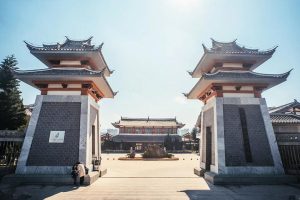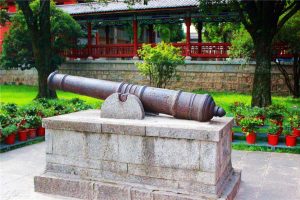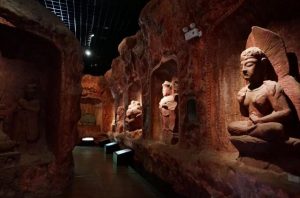
Dali City Museum

Chinese Name: 大理市博物馆
Chinese Pinyin: Da Li Shi Bo Wu Guan
English Name: Dali Municipal Museum
Type: museum
Area: 2650 square meters
Opening Hours: 8:30-17:30, 9:00-17:00 in winter
Recommended Visiting Hours: 1 hour
Ticket: free
Location: southern section of the Fuxing Lu in Dali City

Dali City Museum
Dali City Museum, located in the Neizheng street of Zhongmen Town, Dali City, Yunnan Province. Founded in 1986, the museum enjoys the collection of cultural relics, research and exhibitions in Dali, and is a local comprehensive museum. The museum covers an area of 2,650 square meters mainly displaying stoneware, pottery, bronze, porcelain, jade, stone carving, jade carving, wood carving, calligraphy and painting etc.
Why is Dali City Museum so special?
The mansion was listed as a culture relic under provincial protection in 1993. Due to the significance of Du Wenxiu’s uprising and his resistance to the control by Qing Dynasty, the mansion was appointed as the Patriotism Education Base in 1998 by the Yunnan Provincial Party Committee and the People’s Government of Yunnan Province.
The Dali City Museum has been rated as “Provincial Patriotism Education Base” and “Provincial Science Education Base”. In 2010, it was entitled as the “National Science Education Base”. On May 18, 2009, it is free and open to the whole society.
How to get to Dali City Museum?
Take No.8 bus in Xiaguan Railway Station and get off in FuxinG Road Station, then walk 1000 meters south along Fuxing Road.
Take No.4 bus in Meideng Bridge of Xiaguan and get off in Honglongjing Station, then walk along the Bar Street.
History
Once named the Marshal Mansion, the Museum was originally home to Du Wenxiu(杜文秀) (1828-1872). Du is well known for leading the Hui ethnic minority revolt against the Qing Dynasty (1644-1911) in 1856. Once Du conquered Dali, he was elected Marshal of the military forces and the original mansion of Yunnan Province was re-named the Marshal Mansion. The battle lasted 18 years. The mansion was destroyed soon after Du’s defeat in 1872. It was not until 1884 that the mansion was restored.
Extensive renovations returned the mansion to its original glory, the mansion finally opened to the public as a museum in 1987. The 360 meters (1181 feet) high wall once surrounding the mansion can now only be found in the southern section of the estate. The museum consists of a front hall, a back hall, Meridian Gates inside the mansion and two floral halls in the southern and northern parts. The mansion also boasts many functional rooms: military-political-affair setup, living rooms, studies, and storerooms.
Main Attractions
Flora Hall

The Flora Hall (located in the southern paThe costumes of ethnic groupsrt of the museum) has more than 120 pieces of stone steles carved in different dynasties ranging from Song Dynasty (960-1279) to Qing Dynasty on display. It is reputed as the most influential forest of steles in Yunnan Province. These exhibits provide valuable materials and historical data tracking the development of the local culture in the past dynasties. The Flora Hall (located in the northern part of the museum) showcases stoneware, crockery, bronze implements, porcelains, and jade articles that were excavated in and around Dali. On display throughout the museum are also wood carvings, stone carvings, jade carvings, calligraphies and paintings. The wood caving ‘Manjusri Bodhisattva Riding on a Lion’ has received recognition worldwide while exhibiting in Japan and Switzerland during the 1990s.
Historical Relics Exhibition Hall
Dali has a long history and is known as the “City of Letter”, enjoying many rich cultural heritages. The Beiqiu Site of Yinsuo Island in Dali Haidong is the earliest Neolithic site in Yunnan, dating back more than 5,000 years. In 1253, Yuan Shizu Kublai led troops to destroy the Dali Kingdom and established the Yunnan Province. At the beginning of the Ming Dynasty, the bureaucrats at all levels of Dali were sent from other places, and the productivity was further improved. Dali’s porcelain handicraft industry began to develop. In Qing Dynasty, the Admiral House was set up in Dali, making Dali once again the political, cultural and economic center in Yunnan. The historical exhibition hall displays the remains of these historical developments.
Buddhist Art Exhibition Hall

Dali is known as the Kingdom of Buddhism. In 1978, when the main towers of Chongsheng Temple were repaired, thousands of precious religious relics of the Nanzhao and Dali Kingdom were found. The metal statues of the Dali period were called “Dali Buddha.” The Buddhist Art Exhibition Hall displays Buddhist art statues from different periods unearthed and collected in Dali.
Useful Travel Tips
1.Best Time to Visit Dali City Museum
A lot of festivals and events of Bai nationality focused on March to April each year, travel at this time you will feel rich ethnic customs. And there is a song: “March in Dali has good scenery”, so in the spring, it is suitable whether it is traveling to Dali, or climbing Canshang Mountain, visiting Erhai Lake.
2. What to Pack
Dali belongs to the low altitude plateau monsoon climate and ultraviolet ray is strong. Travelers should bring usual clothes and necessities as well as sunscreen cream and sunglasses to protect yourselves.

 7 Days GolfingTour
7 Days GolfingTour
 8 Days Group Tour
8 Days Group Tour
 8 Days Yunnan Tour
8 Days Yunnan Tour
 7 Days Shangri La Hiking
7 Days Shangri La Hiking
 11 Days Yunnan Tour
11 Days Yunnan Tour
 6 Days Yuanyang Terraces
6 Days Yuanyang Terraces
 11 Days Yunnan Tour
11 Days Yunnan Tour
 8 Days South Yunnan
8 Days South Yunnan
 7 Days Tea Tour
7 Days Tea Tour
 8 Days Muslim Tour
8 Days Muslim Tour
 12 Days Self-Driving
12 Days Self-Driving
 4 Days Haba Climbing
4 Days Haba Climbing
 Tiger Leaping Gorge
Tiger Leaping Gorge
 Stone Forest
Stone Forest
 Yunnan-Tibet
Yunnan-Tibet
 Hani Rice Terraces
Hani Rice Terraces
 Kunming
Kunming
 Lijiang
Lijiang
 Shangri-la
Shangri-la
 Dali
Dali
 XishuangBanna
XishuangBanna
 Honghe
Honghe
 Kunming
Kunming
 Lijiang
Lijiang
 Shangri-la
Shangri-la
 Yuanyang Rice Terraces
Yuanyang Rice Terraces
 Nujiang
Nujiang
 XishuangBanna
XishuangBanna
 Spring City Golf
Spring City Golf
 Snow Mountain Golf
Snow Mountain Golf
 Stone Mountain Golf
Stone Mountain Golf

















